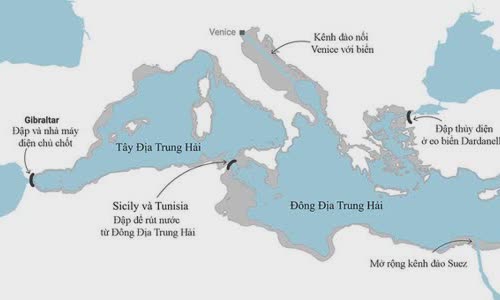The chaos scene after World War I led the German architect Sorgel to believe that the only way to prevent war was to unify Europe and Africa.
After World War I severely damaged Europe, scientists, philosophers and engineers believed that they could solve society's difficult problems with large projects, including

Location of Herman Sorgel's Atlantropa Dams (gray area is a drawdown area) Photo: Hans Hack/Datawrapper.
This Atlantropa plan was first developed by Sorgel in 1927 when he was 42 years old, with the original name Panropa.
He plans to build a network of dams across the Strait of Gibraltar and withdraw water in the Mediterranean.
Location of Herman Sorgel's Atlantropa dams (gray area is a drawdown area).
German architect hopes that with more than 660,000 square kilometers of new land and dams that provide enough electricity for more than 250 million people every day, Europe will enter a new golden age thanks to abundant energy and abundant space.
Sorgel's ideas came about in the context of a rapidly growing European population from 488 million to 534 million in the 1920-1930 period, despite the great number of people killed in the war and the 1918 Spanish flu-
Tensions in European politics were also at their worst in centuries.
Such a background makes the Lebensraum theory, which means "living space", increasingly attracting German politicians.
For the densely populated Central Europe, the yearning for more space leads to the conclusion that there simply isn't enough room to live there.
One of the most surprising is that Sorgel was serious about his plan to withdraw Mediterranean waters.
By the 1930s, when huge engineering projects blossomed, like the construction of the Hoover Dam in the United States, or the Bach Hai-Baltic Canal in the Soviet Union, Atlantropa seemed to become a plausible, even, plausible idea.
With the support and financial backing of many people, and the help of colleagues, Sorgel founded the Atlantropa Institute and attracted public opinion for many years.
Although Sorgel's "surrealistic" scheme was regarded by many Europeans as "visionary", the architect's view of the nation and race was considered to be extremely old-fashioned.
With the dams and bridges built as planned by Sorgel, all the areas and cultures that once concentrated around the sea for centuries will be surrounded by land.
Sorgel also proposed blocking the Congo River and flooding Central Africa without even thinking about the tens of millions of people living there.
According to Sorgel's fantasies of Atlantropa, white Europeans would naturally become the dominant race, using black Africans as a workforce and completely separate from them.
Sorgel once presented ideas to the Nazis, confident that they would support him.
In 1939, Sorgel continued his efforts to promote his ideas with a speech at the World Fair in New York, USA.
After the smog of the devastating war subsided, Sorgel found hope flooding Europe.
Atlantropa attracted the attention of many politicians and tycoons, but even after the fall of the Nazis, Sorgel refused to pull back the racist elements of his vision.
The emergence of nuclear reactors seems to be a sign of the end of Atlantropa, as they give Europe access to much more abundant and practical energy sources than a giant network of dams.
Before leaving, Sorgel wrote four more books, thousands of articles and gave countless lectures on the supercontinent Atlantropa.
On the evening of December 4, 1952, while cycling to the University of Munich to give a lecture, Sorgel was hit by a driver and died.



 Marjorie Marie Webb
Marjorie Marie Webb







